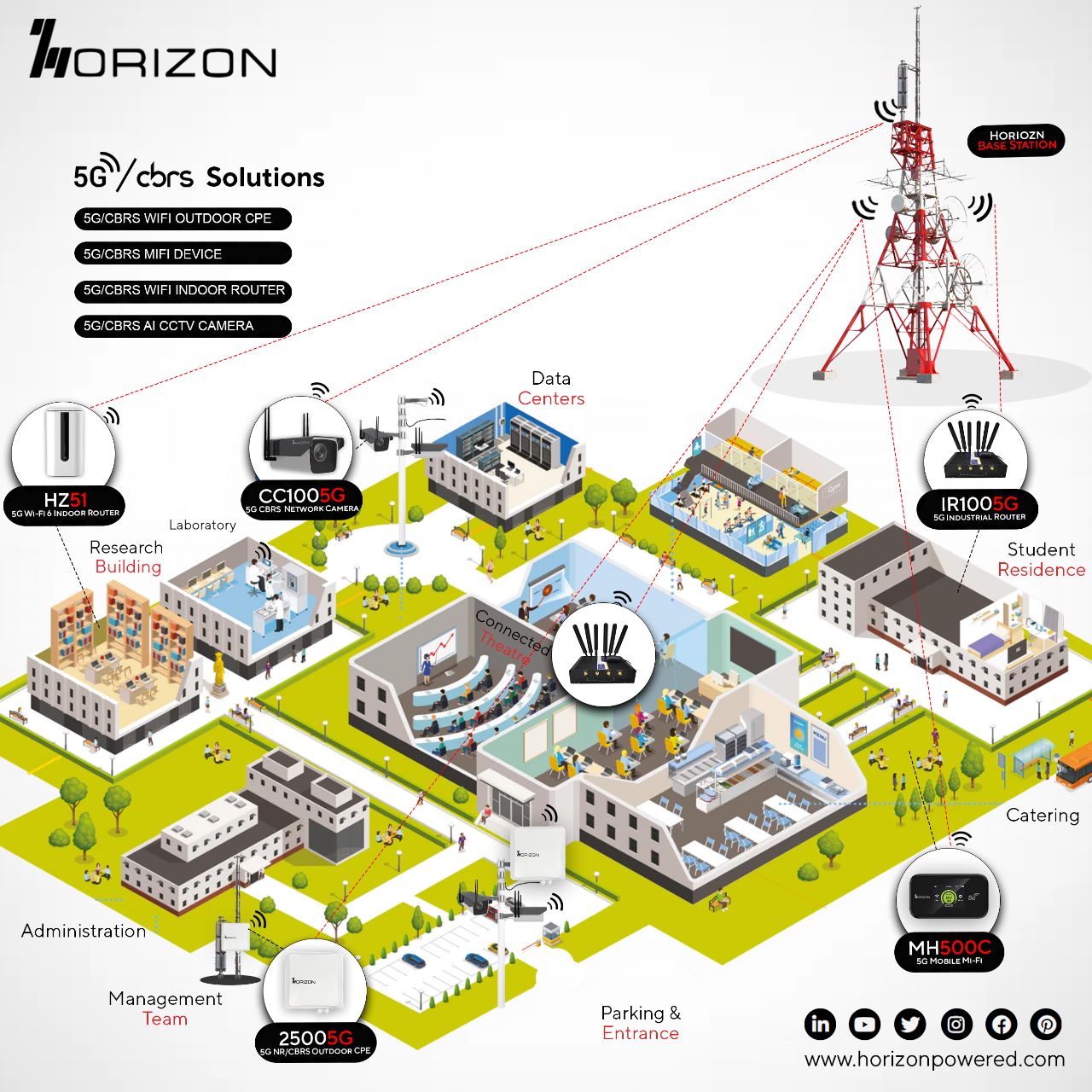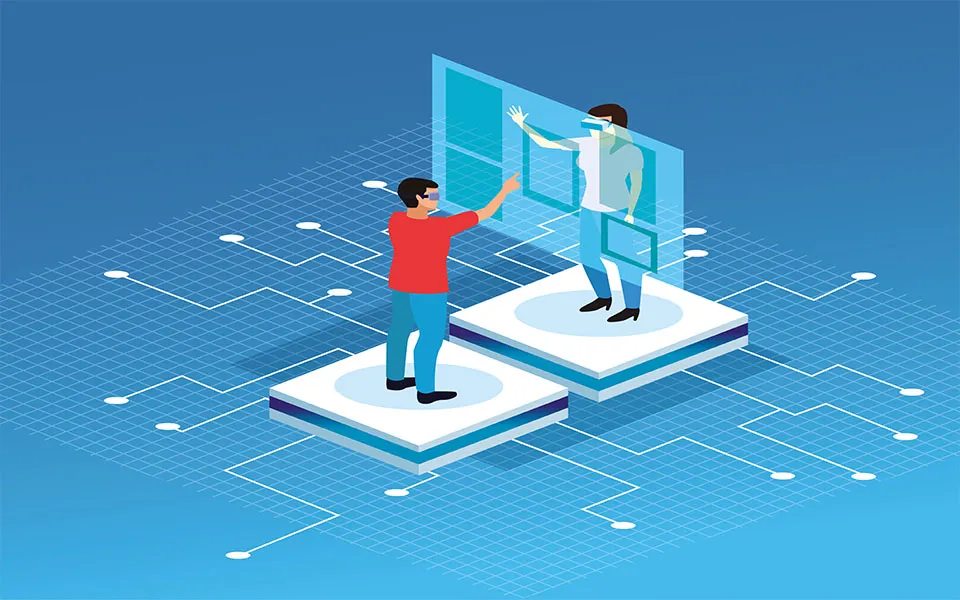5G Citizens Broadband Radio Service (CBRS) Deployment in a University Campus:
A Comprehensive Case Study
Abstract
The integration of cutting-edge technologies in educational institutions has become increasingly imperative to foster innovation, enhance learning experiences, and prepare students for the demands of the digital age. This case study examines the deployment of 5G Citizens Broadband Radio Service (CBRS) in a university campus to demonstrate the transformative impact of this technology on both academic and administrative operations and how Horizon Powered helped achieve that goal. The study outlines the challenges faced, the implementation process, benefits realized, and future prospects for the institution.
In this article, we will explore the different Generations of Industry and its history in time, the crucial role of 5G within Industry 4.0, the impact of AI on various industries, and delve into a case study to exemplify this groundbreaking synergy.
Horizon’s 5G devices IR2005G and 25005G, along with other products, can play an integral role in today’s Industry 4.0 by revolutionizing manufacturing with AI. As part of the fifth-generation cellular network technology, these devices enable lightning-fast and reliable communication, paving the way for advanced automation and smart manufacturing processes

5G's Role within Industry 4.0
Horizon Powered’s team of experts and the university identified several challenges along with discussions with the to necessitate a robust 5G CBRS implementation:
- Connectivity demands: The growing reliance on smartphones, tablets, laptops, and other smart devices within the campus called for higher capacity and faster internet access.
- Capacity congestion: The existing Wi-Fi networks were struggling to cope with the exponential increase in the number of connected devices, leading to reduced performance and user dissatisfaction.
- Seamless mobility: The University needed a wireless infrastructure that could support seamless mobility across the campus, enabling users to stay connected while moving between buildings and outdoor areas.
- Security and Privacy: With a significant amount of sensitive data being exchanged within the university’s network, it was vital to ensure robust security and privacy measures.
- Research and Innovation: The institution aimed to provide its students and faculty members with a platform for innovation and experimentation with emerging technologies.\
The primary objectives of the Horizon Powered 5G CBRS partnership was to deploy solutions to address these challenges and create a future-ready ecosystem conducive to advanced research, experiential learning, and administrative efficiency
Impact on Academics:
The deployment of Horizon Powered’s 5G CBRS Partnership solution had a transformative impact on academics at the University:
- Enhanced Learning Experiences: The high-speed and low-latency 5G network enabled seamless access to online educational resources, virtual labs, and interactive learning platforms, enriching students’ learning experiences.
- Augmented Reality (AR) and Virtual Reality (VR): 5G’s low latency capabilities facilitated the integration of AR and VR technologies into educational modules, allowing students to experience immersive and engaging learning scenarios.
- Remote Learning: During unforeseen circumstances such as the COVID-19 pandemic, the 5G CBRS network supported uninterrupted and high-quality remote learning sessions, ensuring continuity in education.
- IoT Integration: The University leveraged 5G to connect various IoT devices, such as smart boards, sensors, and environmental monitoring systems, enhancing classroom interactivity and resource management.
- Research Advancements: The advanced network infrastructure encouraged faculty members and students to explore cutting-edge research in areas like robotics, artificial intelligence, and smart city technologies.
5G CBRS Deployment:
The deployment process involved multiple stages:
- Needs Assessment: The first step was to conduct a comprehensive needs assessment to determine the specific requirements of various stakeholders, including students, faculty, staff, and administrative departments. This is where Horizon Powered team listed the pros and cons of the devices that could be used.
- Vendor Selection: The University collaborated with Horizon Powered’s team for 5G solution providers to choose the most suitable equipment and solution for the project. The partners were evaluated based on their track record, expertise, and proposed solution.
- Spectrum Allocation: The University acquired the necessary CBRS spectrum through a regulatory process to ensure interference-free operations and adhere to regulatory guidelines.
- Infrastructure Development: The deployment involved installing Horizon Powered’s 5G small cells, Base stations and CBRS products across the campus. These were strategically placed to cover high-density areas, classrooms, laboratories, libraries, and recreational spaces. The strategy and designing of the infrastructure by Horizon Powered’s partnership as to maximize the efficiency and potential of the project.
- Network Integration: The Horizon Powered’s 5G CBRS network partnership solution was integrated with the existing Wi-Fi infrastructure, ensuring seamless handover between the two networks for enhanced mobility.
- Security Measures: Horizon Powered’s Advanced security measures, including encryption, authentication protocols, and intrusion detection systems, were implemented to safeguard data and network integrity.
- Testing and Optimization: Rigorous testing and optimization procedures were carried out by the Horizon Powered’s team to ensure network stability, performance, and coverage.
Impact on Administrative Operations
The Horizon Powered’s 5G CBRS partnership solution deployment also significantly impacted administrative operations at the university:
- Campus Connectivity: Administrators, staff, and guests experienced improved connectivity, facilitating faster data access and communication.
- Facility Management: The deployment enabled IoT-based facility management, optimizing energy consumption and building maintenance.
- Security Surveillance: 5G-powered security cameras provided enhanced video quality and real-time monitoring, ensuring a safer campus environment.
- Traffic Management: The 5G network supported smart traffic management systems within the campus, reducing congestion and improving transportation efficiency.
- Event Management: During large-scale events, the 5G network accommodated the high data demands of attendees, improving event experiences.








